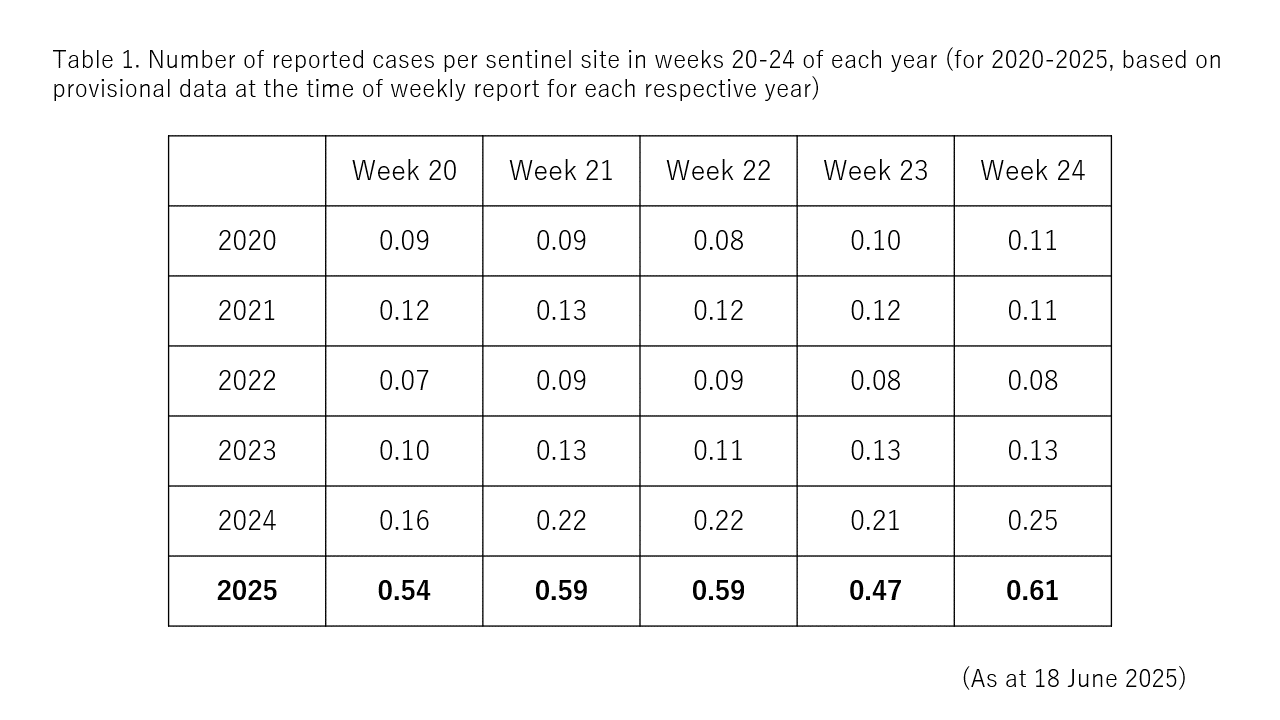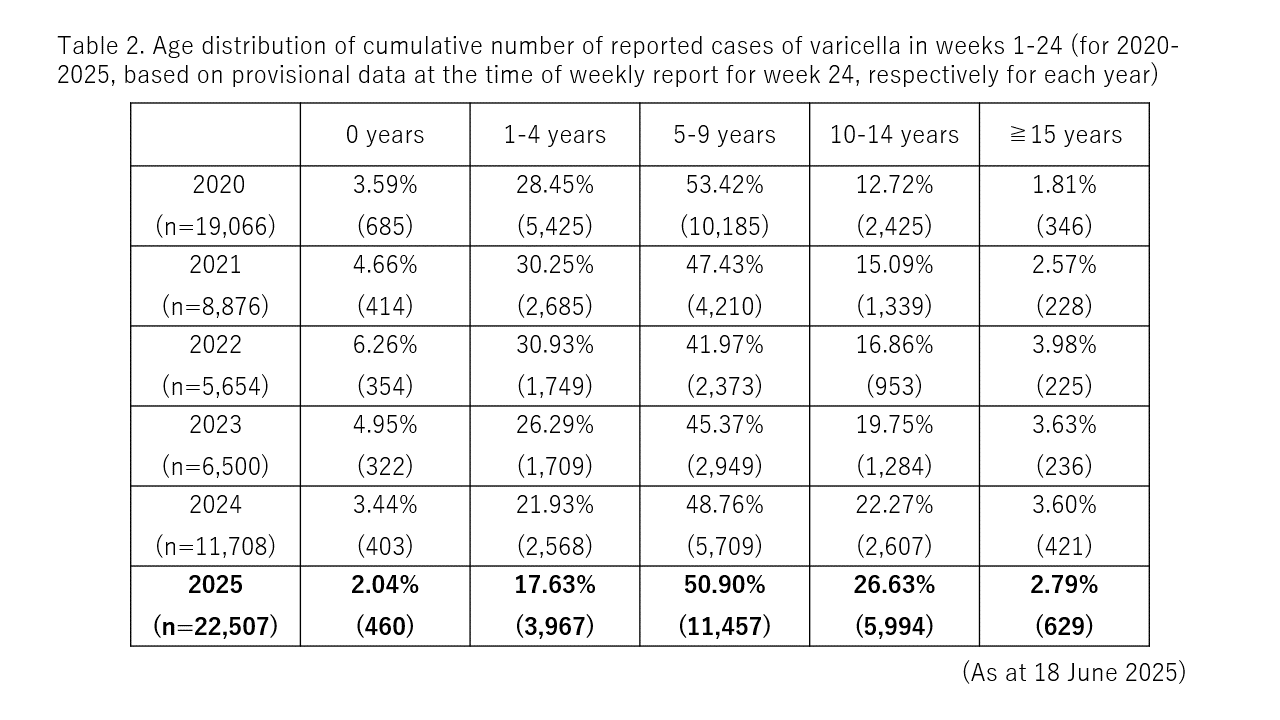Varicella (Chickenpox), Epidemiological week 1-24, 2025 (as at 18 June 2025)
![]()
![]()
◆Varicella (Chickenpox), Epidemiological week 1-24, 2025 (as at 18 June 2025)
Since 2021, the number of reported cases of varicella (chickenpox) in Japan has remained low. However, as at week 24 of 2025, both the cumulative number of reported cases per sentinel site and the cumulative number of hospitalized cases are the highest recorded for the same period in the past 5 years. This article aims to report the latest epidemiological trends of reported varicella cases in Japan in light of the current situation.
Varicella is caused by a primary infection with the Varicella-Zoster Virus (VZV). VZV is highly contagious and is spread mainly by airborne droplets, respiratory secretions, and direct contact. It can also be transmitted by individuals with shingles, which results from the reactivation of latent VZV after primary infection. The main symptoms of varicella are rash, fever, and malaise. The rash typically progresses through multiple stages—erythema, papule, blister, pustule, and crusting—but during the acute phase, these different stages often appear simultaneously. The rash usually starts on the scalp, followed by the trunk and then the limbs. Cases of varicella that occur 42 days or more after varicella vaccination are referred to as breakthrough varicella. In general, these cases are mild with few rashes, and fever may not be present. Although varicella is primarily a mild illness in children with favorable prognosis, certain groups—such as adults, pregnant women, infants, immunocompromised individuals, and those with underlying health conditions or complications—are at higher risk for severe disease. In early pregnancy, varicella infection may lead to fetal death or congenital varicella syndrome. Furthermore, if the mother develops the disease shortly before or after childbirth, the newborn may become severely ill, with an increased risk of death. Varicella is a vaccine-preventable disease, and it was included in the routine immunization schedule in Japan in October 2014. Children aged between 12 and 35 months are eligible for routine vaccination, which is given in two doses at least 3 months apart (typically 6-12 months apart).
Under Japan’s Infectious Diseases Control Law’s National Epidemiological Surveillance of Infectious Diseases (NESID), varicella is classified as a Category V pediatric sentinel surveillance disease. In addition, varicella cases hospitalized for at least 24 hours (including cases where varicella developed during hospitalization for another condition, and at least 24 hours had passed since onset) are subject to notification as a Category V notifiable disease [varicella (limited to hospitalized cases)]. In addition, varicella is designated as a Class II infectious disease under the School Health and Safety Act. Children diagnosed with varicella are required to stay home from school until all rashes have crusted over.
Since 2020, the number of varicella cases reported through pediatric sentinel surveillance has remained low, partly due to the COVID-19 pandemic. However, in week 24 of 2025, the number of reported cases per sentinel site reached 0.61, which is considerably higher than the same week in 2024 (0.25) and in 2019 (0.39), when the number of reported cases per sentinel site in week 24 was highest in recent years. Furthermore, the number of reports per sentinel site over the past five weeks (weeks 20–24) was the highest recorded for this period in the past five years (Table 1).
In week 24 of 2025, the top five prefectures with the highest number of cases reported per sentinel site were Saitama (1.73), Kanagawa (1.40), Tokyo (1.09), Miyazaki (0.87), and Hokkaido (0.80).
During the same week, 1,435 cases were reported from pediatric sentinel sites, with 810 (56%) males and 625 (44%) females. The cumulative number of cases reported in the first 24 weeks of 2025 was 22,507. Compared to the cumulative number of reported cases by age group in weeks 1-24 over the past five years, the proportion of cases in 2025 decreased among those aged 0-4 years and those aged 15 years and older, while the proportion of cases among those aged 5-14 years increased. The cumulative number (n) and percentage of case reports by age group for weeks 1-24 of 2020-2025 are shown in Table 2.
As a category V notifiable disease, all varicella hospitalizations are to be reported. The number of hospitalized cases diagnosed in week 24 of 2025 was 16, and the cumulative number of hospitalized cases reported in the first 24 weeks of 2025 was 294. In the same period over the past five years, the cumulative number of reported cases ranged from 120-220, indicating that the number reported this year is higher compared to recent years. Among the 294 reported cases, 118 cases (40%) were laboratory-confirmed cases that met the pathogen diagnosis required for notification. 176 cases (60%) were clinically diagnosed cases. By sex, 158 cases (54%) were male, and 136 cases (46%) were female, with a median age of 32 years (range: 0-97 years). Regarding vaccination history, 83 cases (28%) had no vaccination history, 27 cases (9%) had one dose, 24 cases (8%) had two doses, and 160 cases (55%) had unknown vaccination history. It should be noted that the notifications also included cases that may not have been strictly differentiated from VZV reactivation.
Since 2021, the annual cumulative number of varicella cases reported per sentinel site has remained below 10, which is low even when compared to 2015-2020, the period following the introduction of routine varicella vaccination. However, as at week 24, 2025, the cumulative number of reported cases per sentinel site reached 8.1, which is comparable to or higher than the levels observed before the COVID-19 pandemic. Therefore, varicella trends should continue to be monitored closely. To prevent the occurrence and reduce the severity of varicella, it is essential to continue routine varicella vaccination in young children who are eligible and to maintain high vaccination coverage.
It should be noted that the selection criteria for sentinel sites in the Implementation manual for the NESID Program were revised in week 15 of 2025, resulting in changes to both the number and the designation of sentinel sites.
For more information and updates on varicella, please refer to the following: (cited on 18 June 2025, all articles in Japanese, except for WHO link):
- Varicella (MHLW)
https://www.mhlw.go.jp/stf/seisakunitsuite/bunya/kenkou_iryou/kenkou/kekkaku-kansenshou/chickenpox.html - Varicella vaccine (MHLW)
https://www.mhlw.go.jp/stf/seisakunitsuite/bunya/kenkou_iryou/kenkou/kekkaku-kansenshou/yobou-sesshu/vaccine/chickenpox/index.html - Comparison with past 10 years, Weekly Report (NIID, JIHS)
https://id-info.jihs.go.jp/surveillance/idwr/graph/weekly/005/varicella.html - Changes in varicella trends after implementation of routine varicella vaccination - From NESID, as at week 26, 2021 (NIID, JIHS)
https://id-info.jihs.go.jp/niid/ja/varicella-m/varicella-idwrs/10892-varicella-20220113.html - Trends and vaccines for varicella and shingles (IASR Vol. 39)
https://id-info.jihs.go.jp/niid/ja/varicella-m/varicella-iasrtpc/8223-462t.html - Pathogen Detection Manual, VZV (NIID, JIHS)
https://id-info.jihs.go.jp/relevant/manual/010/vzv_2011.pdf - To children receiving vaccinations and their parents (MHLW)
https://www.mhlw.go.jp/seisakunitsuite/bunya/kenkou_iryou/kenkou/kekkaku-kansenshou/tool/dl/leaf01-08.pdf - Chickenpox (WHO)
https://www.who.int/news-room/questions-and-answers/item/chickenpox
Department of Infectious Disease Surveillance
Center for Public Health Action in Applied Epidemiology
Department of Immunization Research
National Institute of Infectious Diseases, Japan Institute for Health Security

